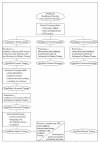Effectiveness of a training-of-trainers model in a HIV counseling and testing program in the Caribbean Region
- PMID: 19222839
- PMCID: PMC2653459
- DOI: 10.1186/1478-4491-7-11
Effectiveness of a training-of-trainers model in a HIV counseling and testing program in the Caribbean Region
Abstract
Objectives: To evaluate the effectiveness and sustainability of a voluntary counseling and testing (VCT) training program based on a training-of-trainers (TOT) model in the Caribbean Region, we gathered data on the percentage of participants trained as VCT providers who were providing VCT services, and those trained as VCT trainers who were conducting VCT training.
Methods: The VCT training program trained 3,489 providers in VCT clinical skills and 167 in VCT training skills within a defined timeframe. An information-monitoring system tracked HIV trainings conducted, along with information about course participants and trainers. Drawing from this database, a telephone survey followed up on program-trained VCT providers; an external evaluation analyzed data on VCT trainers.
Results: Almost 65% of trained VCT providers could be confirmed as currently providing VCT services. This percentage did not decrease significantly with time. Of the VCT trainers, 80% became certified as trainers by teaching at least one course; of these, 66% taught more than one course.
Conclusion: A TOT-based training program is an effective and sustainable method for rapid scale-up of VCT services and training capacity in a large-scale VCT program.
Figures


References
-
- UNAIDS/WHO UNAIDS/WHO Policy Statement on HIV testing. 2004. http://data.unaids.org/una-docs/hivtestingpolicy_en.pdf
LinkOut - more resources
Full Text Sources

